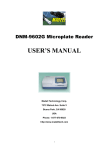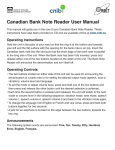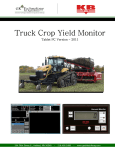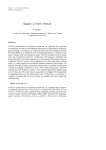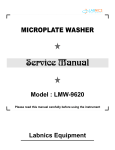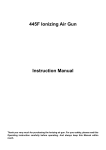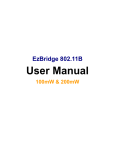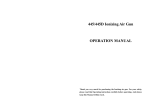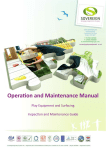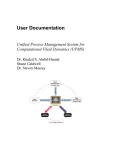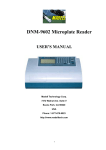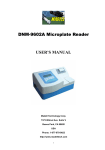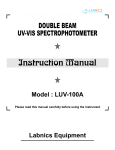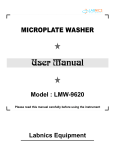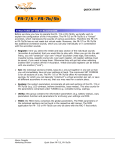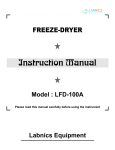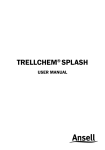Download Microplate Reader LMR 9602G
Transcript
MICROPLATE READER User’s Manual Model : LMR - 9602G Labnics Equipment Please read the manual carefully before using the instrument. Some Precautions and Security Prompts LMR-9602G Microplate Reader is specially used for vitro diagnosis. Please take the following precautions before using the instrument and strictly follow them. 1. Take protective measures before turning on the instrument by wearing gloves and other defending clothes as some samples may have some adverse effects. 2. Do not randomly discard the used sample. All samples, negative or positive controls, standards and waste should be treated as infectant. 3. The instrument wires should be connected properly to avoid electric shock, especially ground wires should be connected properly with the ground. 4. The AC power supply should be stabilized. Avoid using the same power supply with highpower equipments (especially break frequently) and avoid disturbing by strong electromagnetism. 5. To drag off the power wire, hold the plug itself instead of power wire. 6. If you find smog, peculiar smell or strange sound coming from the instrument, please cut off the power supply immediately and contact the franchiser. 7. Cut off the power supply of instrument and cover it with dustproof cover after completing the detection process. 8. If you need to uninstall the cover for repair or other causes, you should first turn off the instrument and then cut off the power supply. 9. While working with the instrument, wear rubber gloves and after completing your work wash your hand to avoid any kind of infection. 10. Be careful while handling reagents or patient samples by hand or other body parts and in case your body wound comes in contact with the patient sample, wash immediately and consult doctor. 11. This is a clinical detection equipment and has no taboos. Table of Content Chapter Contents 1 1.1 1.2 1.3 1.4 1.5 2 2.1 2.2 2.3 3 3.1 3.2 3.3 4 4.1 4.2 5 5.1 5.2 6 7 7.1 7.2 8 9 10 11 12 13 INTRODUCTION Characters Main Functions Denominating Rule Working Conditions Dimensions and Weight PRINCIPLE AND FEATURES Working Principle Structure Features System Configuration SPECIFICATIONS Functions Technical Specifications Power Supply PANEL Back Panel Preparation and Examination PROGRAMMING Programming Introduction Programming Operation DETECTION SYSTEM SETTING Time Setting Wavelength Setting INQUIRY MAINTENANCE TRANSPORTATION PACKING LIST QUALITY GUARANTEE WARNING SERVICE REPORT Pg. No. 1 1 1 1 1 1 1 1 1 2 2 2 2 3 3 3 3 4 4 5 11 14 14 14 14 15 15 15 16 16 17 Chapter 1. INTRODUCTION:1.1 Characters The LMR-9602G Microplate Reader is a semiautomated benchtop instrument used in clinical immunity-tests in hospitals or epidemic preventing stations. It has unique features such as high sensitivity, high accuracy, high detection speed and smooth running of operation etc. Display is a liquid crystal one with alphanumeric and graphic options. Parameters can be checked on the display without using difficult command sequences. 1.2 Main Functions 1) The instrument is mostly used for the detections of viruses, germina, tumour detection, human body's hormones and other items based on the principles of immunology in the clinical tests. 2) Corresponding detection for microanalysis in chemistry or biochemistry. 1.3 Denominating Rule LMR-9602G Serial Number Designing Number Symbol of the Instrument Symbol of Computer 1.4 Working Conditions 1) (1) Environmental temperature: 10~30°C 2) (2) Relative humidity: =70% 3) Keep it away from strong electromagnetic field and avoid direct irradiation by strong light. 4) Avoid dust and shake. There must be no caustic gas such as hydrochloric acid in air. 5) After switching on the instrument wait for 20 minutes, before starting the experiment so that the equipment gets warm up. 1.5 Dimensions and Weight Dimension: 420L×325H×210W mm Weight: 10 kg Chapter 2. PRINCIPLE AND FEATURES:2.1 Working Principle This instrument works on the principle of "Photoelectric Colorimetry". It can detect the absorbance of detecting sample and standard liquid. Also it can analyze and calculate the absorbance value and finally produce the values or the condition for detecting sample in the liquid. 2.2 Structure Features The instrument has two main components: "the mainframe" and "the printer". The mainframe composed of optic system, 8-channel detection system, singlechip system and enzymatic plate driving system. Instrument can detect enzymatic plate that has 96 or 48 wells. -1- 2.3 System Configuration Optic system Lamp 8 Channel Prismatic organ Enzymatic plate Photoelectric detection Drive circuit Steady-voltage power Display Simulative-signal disposal and A/D-conversion circuit CPU Keyboard Printer Rs232 serial port Fig. 1: System Configuration Chapter 3. SPECIFICATIONS 3.1 Functions (1) Detect absorbance as well as used in qualitative, quantitative and kinetic detection. (2) It can store maximum 120 programmes in general use and display programs parameters on LCD. (3) The instrument can automatically select filters for different items. (4) On starting the instrument, it will first undergo auto-check process by checking initial settings and if there is some error, the corresponding prompt will appear on the screen. (5) The instrument has printing function. 3.2 Technical Specifications: (1) Range of working wavelength is from 400nm to 700nm. It has 4 filters when leaving factory: 405nm, 450nm, 492nm, 630nm (2) Characters of the filters Accuracy of wave (nm) Half-width (nm) =12 ±3.0 Table 1: Characters of the Filters (3) Detection range of instrument is from 0.1A to 3.0A. The errors of absorbance accuracy are as follows: Absorbance (A) 0.1--1.0 >1.0--2.0 >2.0--3.0 ?3.0--4.0 Accuracy Error ±1.0% or ±0.01A ±2.0% or ±0.02A ±5.0% or ±0.05A ±8.0% or ±0.15A Table 2: Absorbance Accuracy -2- (4) Linearity of the Instrument Absorbance (A) 0.1--1.0 >1.0--2.0 >2.0--3.0 >3.0--4.0 Error (%) ±0.8 ±1.0 ±3.0 ±6.0 Table 3: Linearity of the Instrument (5) Reproducibility Error: (6) Stability Error: (7) Detection Modes: (8) Display: (9) Print: (10) Communication: (11) Output: ?0.5% ?±0.005A/10min single wavelength or dual wavelengths 320 x 240 pixels LCD screen External printer RS232 serial port Absorbance, cut-off value, qualitative judgment, value of P/CO, concentration, judgment of normal value and quality control value 3.3 Power Supply (1) Voltage: 220V x?1±10%? (2) Frequency: 50 Hz x?1±2%? (3) Power supply must be earthed perfectly. Chapter 4. PANEL 4.1 Back Panel Fig. 3: Back Panel 4.2 Preparation and Examination First examine the instrument whether having scathes such as distortion or cracks due to inappropriate transportation and storage. If there isn't any scathe, insert plug into the electric socket and switch on the instrument. Now instrument will start auto-check process and if there is something wrong, corresponding prompt will appear on the screen. For example, if filter fails, instrument prompt as "Filter Failure"; if the optical system has malfunction, prompt will appear on screen as "Optical System Failure". So correct these errors before using the instrument. After that if auto-check process gets over, machine will go to the main menu and wait for further orders. At that time, you can operate (program, detect, inquire) according to your demands. Before you begin to detect, Wait for 20 minutes since turning on the instrument so that the instrument get a complete warm up. If instrument doesn't get any command for 30 minutes, it will automatically comes to sleeping state in order to prolong its life. When you start operating again, instrument will return to its normal state. -3- Chapter 5. PROGRAMMING Before beginning detection, you should first decide the order of programs according to the needs for your convenience, order of program numbers should be based on the following principles: (1) Put the most commonly used detection items in the front and arrange combined items together. (2) Because the instrument only allows five items to process quality controls synchronously, you should arrange the items accordingly which needs quality control according to their preference. 5.1 Programming Introduction 5.1.1 The following picture is the main menu of the Instrument. Explanation: Detect: After programming is finished, you can click on the icon to start detection process. It then allows to select item, set the row and column number and decide whether to use the calibrating factors saved in the instrument or not. Program: Click the icon to enter the interface of programming. The instrument can save 120 programs (from 0 to 119). Set: The instrument allows setting wavelengths, system time and deleting all saved items, detection results, quality control results and the calibrating factors. Inquire: Query the results of quality control, detection results or parameters of programs. Time: After clicking on the Time icon, the current time will be shown on the bottom of the display. This time will be appearing for few seconds and then it will return to the main menu. Finish: After clicking on the Finish icon, the tray returns to the instrument and then does not respond for other icons; till you click the icon again to make the tray comes out and after that you can click on other functional icons. Caution: After clicking on the finish icon, the system will save some important parameters (For example, results of quality control and detection results). So you must click the icon of Finish and wait till the tray returns to the instrument. Then turn off the instrument. 5.1.2 When you need to input some numbers, click the inputting position. Then a keyboard will be displayed as: -4- You can directly click the number you want to select. When all the numbers have been entered, press ENTER . If the number needs to be changed, please click the button DEL to delete the number entered and enter it again. The item name may be a combination of numbers and letters. Now when you click on the inputting position of item name, a keyboard will be displayed as: In the above keyboard, 1/A means a conversion between number and letter. When it is converted to letter, the button EXIT will appear for selecting letters from A to Z. When the well's position is required to select, the keyboard will be displayed as: At this moment, a letter will appear after first clicking and further corresponding number after second clicking. 5.1.3 There is a status bar on the left side of the display when you are programming. Click on the up arrow button to return to the previous menu and on the down arrow button to go to the next menu. 5.1.4 You can easily set blank, negative, positive and quality-control wells on the enzymatic plate when you are doing qualitative detection. For ex. you can set blank, negative and positive wells from 1 to 3, respectively. But the quality control well should not be more than one. When you are doing quantitative detection, you can set standard wells from small to large values according to rows or columns. 5.1.5 In the process of programming, you can click the icon on the left bottom to exit programming and return to the main menu. 5.2 Programming Operation 5.2.1 Programming Click the Program icon in the main menu. The next display will show, for example: Explanation: 1. After you click "Item No.", the keyboard will appear. Then you can enter the item No. (0-119). 2. Click on "Item Name" icon to input the name of program. The name may be a combination of numbers and letters, for example 8IG. If you have not entered a name, the system will designate a default one. 3. Select working mode either as single wavelength or dual wavelength based on the reagent specification. (The pink box means the current selection.) Click the number of wavelength to change the inputted value?see the function of SET?. 4. Select single well detection or dual wells detection. If you select the latter, the instrument will combine two wells in the row direction as "A1, A2", "A3, and A4" …"H11, H12" and use the means of two absorbance. 5 If you want to exit programming, click on the up arrow in the status bar on the right side of the screen or click the icon at the left bottom. Click on the down arrow to go to the next programming interface. -5- 5.2.2 Vibration Mode and Detection Mode Explanation: 1. Instrument has vibration function. But we suggest you to use external vibration if you have. 2. If you just want to get the absorbance of sample and do not need any analysis and calculation, please select "Absorbance". 3. If you need to check the quality (positive or negative) of sample, please select "Qualitative Detection". Between the two qualitative modes: "CUT-OFF Mode" uses the calculated value as the cut-off value and "CUT-OFF Control" uses the absorbance of the lower positive well as the cut-off value. 4. If you need to check the concentration of sample, please select "Quantitative Detection". 5. Click icon at the left bottom to exit programming, click on the up arrow in the status bar to return to the first interface of programming and click on the down arrow in the status bar to go to the next interface. 5.2.3 Set Blank Well Instrument allows setting blank wells randomly and thus set 8 blank wells at a time. User can select the mode of "Average Column Blank Wells" and set all the 8 wells of one column as blank wells. Explanation: 1. First select "Randomly Set", click on the strings 564555 and enter5 the number of blank wells. Then enter the positions of blank wells. When you select "Average Column Blank Wells", directly enter the column number and no need of putting position of every well. 2. Click the icon at the left bottom to exit programming. Click on the up arrow in the status bar to return to the interface of "Vibration mode" and detection mode". Click on the down arrow in the status bar to go to the next interface. 5.2.4 Qualitative Detection Mode 5.2.4.1 Calculation Mode 5.2.4.1.1 CUT-OFF Mode Select the "CUT-OFF Mode" which is qualitative detection mode in the interface of "Detection Mode" and enter -6- the interface of "Blank Well". Now click on the down arrow in the interface to enter into the next interface to set calculation mode, qualitative mode and negative comparison value. Explanation: 1. The definitions of letters in above formula are as follows: NCV----Negative Comparison Value S----Absorbance of the Sample N----Average Absorbance of Negative-control P----Average Absorbance of Positive-control A, B, F, A1, B1, F1, A2, B2, F2----Parameters requires to enter?according to reagent specification?. CO, CO1, CO2----Cut-off values used for judgment. 2. Click on "Single", so that the instrument display next interface for entering the parameters: A, B, F. Now enter the three parameters according to the reagent specification. Click on the down arrow in the status bar to finish the operation of entering three parameters. The parameters set will not display in the process of programming, but appears in detection. If the calculation mode is "Single", "+" means positive and "-" means negative. 3. The "Dual" calculation mode requires entering two groups of parameters. The first group is A1?B1 and F1. The second group is A2?B2 and F2. Take these two cut-off values as upper limit and lower limit to judge quality (positive or negative). Inputting method is same as that of "Single". If the calculation mode is "Dual", "+" means positive; "-" means negative; " "(blank) means the absorbance value is between the two cut-off values. 4. Enter two parameters at the "Limit Value" position. (Click on underline and the keyboard appears). Here two parameters are the upper limit and the lower limit for subsection of absorbance respectively. Make sure that the difference of two parameters comes up to 10 average shares. The difference between the two absorbance value and the lower limit is put to the corresponding subsection. The result is a number from 0 to 9. For example, input two parameters 0.5 and 1.0. Average subsection is 0.05. If the absorbance is 0.6, the difference between the sample's absorbance and the lower limit is 0.1 and then the result is 2. 5. Reagent specification prescribes that when the negative-control value is less than the input value (for example: 0.05) you should calculate according to the input value, so please click on the corresponding underline and enter the regulated value. But if reagent specification prescribes that the negative-control value is more than the input value (for example: 1.20) you should calculate according to the input value, so please click on the corresponding underline and enter the regulated value. 6. Click the little icon at the left bottom to exit programming. Click the up arrow in the status bar to return to the interface of blank wells setting and Click on the down arrow in the status bar to go to the next interface. 5.2.4.1.2 CUT-OFF Control Select the "CUT-OFF Control" qualitative detection mode in the interface of "Detection Mode" and enter the interface of "Blank Well". Click on the down arrow in the interface to enter into the next interface. -7- Explanation: 1. The definitions of letters in the above formula are as follows: S----Absorbance of the Sample; L.P.C.----Lower Positive Control Value; NCV----Negative Comparison Value 2. "Equivocal Range" is the uncertain range, that if the calculation result lie in this range, it is very difficult to say about the sample quality whether it is positive or negative. For example if you enter 0.1 before "L.P.C.", it means the equivocal range is from 0.9*L.P.C. to 1.1*L.P.C. That means, if the L.P.C. (lower positive control value) is 1, then the calculation results from 0.9 to 1.1 are equivocal. 3. Reagent specification prescribes that when the negative control value is less than the input value (for example: 0.05) you should calculate according to the input value, so click on the corresponding underline and enter the prescribed value. If the reagent specification prescribes that the negative control value is more than the input value (for example: 1.20) you should calculate according to the input value, then click on the corresponding underline and enter the prescribed value. 4. Click the little icon at the left bottom to exit programming. Click on the up arrow in the status bar to return to the interface of blank wells setting. Click on the down arrow in the status bar to go into the next interface. 5.2.4.2 Invalidity Judgment and Wells Setting Explanation: 1. Reagent specifications of some detected items have prescribed the validity judgment for the absorbance of positive-control and negative-control to ensure the validity of detection results. In such circumstance, enter the prescriptive value as the reagent specification demand. If reagent specification has no requirement, do not enter and thus instrument doesn't perform the validity judgment when detecting. 2. The quality control well must be one. When you enter negative or positive wells, please enter its number first and then enter its position. 3. If there is no change in the input items and you wish to use them when detecting, please click on the icon "Save". Click the icon "Exit" to quit this programming. Click on the up arrow in the status bar to return to the superior interface. Thus, the programming of qualitative detection mode is complete. -8- 5.2.5 Quantitative Detection Mode 5.2.5.1 Detection Mode Click "Quantitative Detection" in the interface of "Detection Mode" and enter the interface of "Blank Well". Click on the down arrow in the interface to enter the next interface to set calculation method. Explanation: 1. Click the icon at the left bottom to exit programming. Click on the up arrow in the status bar to return to the previous interface while click on the down arrow in the status bar to go to the next interface. 5.2.5.2 Set Wells Explanation: 1. Click underline after "Dilution Factor" to enter the real dilution multiple. When the detection mode is "Ratio Logarithmic Technique", the factor input is used for calculating calculation coefficient (revised factor). 2. "Unit" means the unit of concentration. It may be mg/l, mg/dl etc. Please enter the unit according to the reagent specification. 3. Enter the number of the standard wells and positions of each well. The instrument will show the positions of standard wells when it displays the item information before detection. 4. There is one quality control well. You should select whether to have quality control well or not. 5. Click the icon at the left bottom to exit programming. Click on the up arrow in the status bar to return to the previous interface. Click on the down arrow in the status bar to go to the next interface. 5.2.5.3 Set Standard Values -9- Explanation: 1. Click on "Concentration" to enter the standard concentrations as the reagent specification prescribed in order from small values to large values. Please input two concentrations each line. (Use keyboard to enter the values and then press ENTER to finish this inputting. Precaution: When the detection method is logarithm method, you can't input the first concentration value if it is "0", otherwise the detection results will be wrong. 5. If you need to judge the normal values, click "Normal Value" and then enter two normal values. 6. Click "Save" to store the item parameters in the instrument and then return back to the main menu. If you click on "Exit", the instrument will not save the parameters. Now click on the up arrow to return to the previous interface. 5.2.6 Absorbance Detection Mode Click "Absorbance" in the interface of "Detection Mode" and then click on the down arrow in the status bar to enter into the interface of blank wells setting. After you set the blank wells, click on the down arrow in the status bar. Then save the results. The operations are same as above. 5.2.7 Kinetic Detection Mode 5.2.7.1 Click "Kinetic Detection" in the interface of "Detection Mode" and then click on the down arrow in the status bar to enter the following interface. Explanation: 1. Click underline to enter the corresponding parameters. Unit of delay time and detection time is second. The instrument will adjust interval between two detections based on the detection time. (The sampling time is 6 seconds in the detection period.) 2. Calculating Formula: Activity of enzyme = % A/min×F (IU/L) In above formula, F means factor. - 10 - Chapter 6. DETECTION This instrument can be used for clinical tests after being programmed. To ensure veracity of detection results, please note the following items: (1) Wells of blank, negative control, positive control or standards on the board should be consistent with program. (2) If reagent has been changed, you should use the new negative control, positive control and standards to calibrate. (3) Strictly accord to the reagent specification to detect. (4) Create indoor quality control system and assure the quality state of real detection in time by detecting the quality control samples. 6.1 Switch on the instrument and then first start the auto-check process. After auto-check process gets over, it will display the main menu. At that time, you should not detect immediately, wait for 20 minutes for a complete warm up and then start detecting. 6.2 Click on "Detect" in the main menu, and the following detection interface appears. For example: The LCD shows item names and item numbers of 18 programs at a time. Click on the down arrow in the status bar to see parameters of other programs. Please select a program number before detection. After selection, click the icon to return to the main menu. The instrument consist of saved values of calibrating factors of quantitative detection and the cut-off values (CO1, CO2) of qualitative detection. If it is qualitative detection, the saved cut-off values CO1, Co2 will be displayed; if it is quantitative detection, the saved calibrating factors a and b will be displayed. The absorbency of the standard will also be displayed if the quantitative detection mode is "Point to Point Technique" or "Interpolation Technique". You can use these saved parameters to calculate (click the corresponding parameter to change) or select "Use result of this detection". If you select the later one, please add standard liquids to calibrate again and use the new results to calculate. If you select the former, the sample can be put on the standard wells to detect. - 11 - 6.3 Click on the "up arrow" in the status bar to return to the previous interface or click on the "down arrow" to show information on the detected item selected. When the correct information has been displayed, continue to click the "down arrow" to begin detection. 6.4 When detection starts, screen display "Detecting now", wait for few seconds, till detection gets finished. Now instrument displays absorbance of every well, then it will give the result of qualitative or quantitative detection. Results from column 1 to column 6 first appear on LCD. If you wish to see the results from column 7 to column 12, please click on "Next" button at the bottom of the display. The symbol of "*" means there is no detection at this position. If you want to print the absorbance, please click PRINT . Click ENTER to go into the next interface or return. If the detecting results need to be stored for query, click SAVE . The instrument then sends all the data to the printer together. You can do other operations once the printing starts and needn't wait. The printing format shows as table 3. Explanation: The program decides the output of detecting results. Detected results are mainly four: (1) Absorbance (2) Result of Cut-off Judgment (+, -) and value of P/CO (3) Concentration (4) Judgment based on Normal Concentration Value (H, L). If detected result has concentration value as 99999, it means the concentration of the sample is beyond the linear range. You should dilute it and detect again. 6.5 When results need to be transferred to the external PC, first connect the signal wire and then wait till the PC comes in a state of waiting. (Please see the user's manual of Software of LMR-9602G Microplate Reader.) When screen show the absorbance, click then the picture of appears on the screen. It means data is transferring now. Until the transmitting is finished?the picture of does not disappear. 6.6 When above all work is over, take the enzymatic board out. If you still want to continue detection of the item, replace a new enzymatic board and repeat the operating steps since step 6.4. If then also you wish to detect other items, please repeat operating steps since step 6.1. 6.7 After all the detection items are finished, return to the main menu. Click on "Finish", so that the tray of enzymatic board will return to the instrument automatically (if you click on "Finish" again, the tray of the enzymatic board will come out). Then shut off the power supply, and pull out the plug. 6.8 When the detection method is kinetic type, the display will show the A-T reaction chart after detection. Click the icon at the bottom to switch the sample from 1 to 8. - 12 - 6.9 When the calculation mode is "Linear Technique", "Semi-log Technique", "Total Logarithmic Technique" or "Ratio Logarithmic Technique" of quantitative detection, select the item of "Use results of this detection", the screen displays the standard curve after detection. For example: The Y-coordinate may be absorbency (A) or log10 (A) and the abscissa may be concentration(C) or log10(C), which is decided by the selected calculation mode. The line is decided by the calibrating factor. The letter "r" denotes the lineal correlating ratio and the pink box denotes the detection value of the standard liquid. You can click the icon of "Edit" to change the absorbency of the standard liquids. For example: Click the corresponding position of the number and input a new absorbency. When the new number has been entered, click the up or down arrow in the status bar and return to the interface where calibrating curve appears. Then calculate the correlating ratio again. If you click "Next", it will calculate the sample's concentration using the calibrating factor displayed in this interface. The calibrating factor a and b will appear and get changed at the beginning of detection. - 13 - Chapter 7. SYSTEM SETTING Click on "Set" in the main menu, and then the following interface appears. For example: 7.1 Time Setting When there is something wrong with "date or time" displayed on the screen, you can select the "function" and enter the right date and time in turn in the next menu. First click on "position" and then use the keyboard at the bottom to enter. (The bit you enter is decided by the symbol of *.) 7.2 Wavelength Setting 7.2.1 Enter the wavelengths (nm) of filters in turn. Pay attention to make the input data accord with the arrangement of the filters in the tray, otherwise it will cause wrong results. There are four filters in the instrument, and they are arranged as: 405nm, 450nm, 492nm and 630nm. 7.2.2 The instrument can maximum set 10 filters. If the number of wavelength is less than 10, enter 0. 7.2.3 Continue clicking "Delete all items", and then the numbers of 1, 2, 3 appears. When number 3 appears, the instrument will save all items information and the wavelengths set. But all the detection results will be deleted. 7.2.4 The function of "Debug" is to check the work parameters when the instrument is maintaining. Click the icon of "STOP" to exit the function. Chapter 8. INQUIRY The function is designed for inquiring the saved quality-control data and detection results. Click "Inquire" on the main menu, and then the following interface appears. Explanation: 1. If you want to print the quality-control results, click on "Result of QC". The screen displays the symbol of * that means symbol the item number (0-5). The six items are quality-control items detected in this month. When you enter the item number, the LCD shows the data of this item. - 14 - 2. When "Detection Result" is selected, the screen will display the list of detection results. Enter the result number you want to inquire so that it will display the saved result. There are 100 results saved in the instrument. Click on "up arrow" or the "down arrow" to go to the other interface. Click the icon of "STOP" to exit inquiry. 3. When instrument displays the detection results or the quality-control results, a keyboard appears at the bottom. NEXT SAVE PRINT TRANS ENTER When user wants to inquire the detection results, the user should select "Print" or "Trans" and keep in mind that the function of "Save" is invalid. But when instrument displays the quality-control results, the functions of "Trans" and "Save" are invalid. Click the button of "Next", and then it will displays "X= "and "SD= ". You should enter the two parameters based on reagent specification. Then the quality control chart will generate and it can be printed. 4. The format of "Item Information" is same as that appeared on the interface of detection. Click on "Item Information", and display shows "****". At this moment, enter the item number (1-3 bits) and click ENTER . 5. Click on "up or down arrow" in the status bar to leave the interface. Chapter 9. MAINTENANCE Instrument needs cleaning only in normal usage. But the following assemblies will be invalid or have malfunctions after a long time usage. You may as well maintain them under the guidance of professional. 9.1 Filter The transmission rate of filters will be decline after a period of usage. When the instrument doesn't work properly, it will give you a clue or prompt. In order to maintain the accuracy of detection, invalid filter must be changed by professional time to time. 9.2 Lamp The instrument will prompt, if the light lamp fails. At that time, you should open the lid of the instrument and examine it. If lamp is not working properly, please change it with same standard lamp. If something is wrong with the power, repair it. 9.3 Tray If there is something wrong with the tray (it can't pass in and out of the instrument), possible reasons for this error are: may be the down lead of step-motor is not properly connected; synchronous strap may be loose or doffed; moving parts shift and get blocked etc. So find out the reason behind this error get rid of the malfunction. 9.4 Fuse If fuse burns out, cut off the power supply first, and then change the fuse with the same standard. You may change the fuse under the professional's guidance. Chapter 10. TRANSPORTATION o o 1. Range of Environmental Temperature: - 20 C ~ +55 C 2. Relative Humidity of Environment: =93% 3. Range of Atmosphere Pressure: 500hpa~1060hpa. Chapter 11 PACKING LIST:(1) (2) (3) (4) (5) (6) Name LMR-9602G Microplate Reader Printer User's Manual Product Certificate Users Checking and Accepting Sheet Accessories a. Wire for Power Supply b. Fuse φ5×20 2A c. Plastic Cover - 15 - Number 1 1 1 1 1 1 2 1 Chapter 12. QUALITY GUARANTEE:We will repair or replace the instrument or accessories free of cost if there is any problem with the instrument, provided that you have complied with the instructions of this user's manual, and it is within one year from the date of purchase. You will be charged if you have not followed this user's manual or you have disassembled the instrument without authorization. Our company will answer maintenance related questions for the instrument even after the one-year warranty period. Chapter 13. WARNING:(1) The power wire should be earthed properly. (2) Filter must be changed by the professional. - 16 - SERVICE REPORT Tel.No.: Customer’s Address : Fax No.: Weekly Off.: Dept.: Contact Person / Designation : Time Date From To System Configuration Date : Model SR. No. Serial No. Status : OK Installation Not OK Warranty Demonstration Maintenance Contract Repairs Application Billable Calibration Validation Courtesy Nature of Problem : Observation & Action Taken : Customer’s Remarks : Parts Replaced : Parts Recommended / Action Required : Yes No Service Engineer’s Name & Signature Requisition Number : Customer’s Name, Signature, Date & Stamp Page ____ Of ____ - 17 -




















